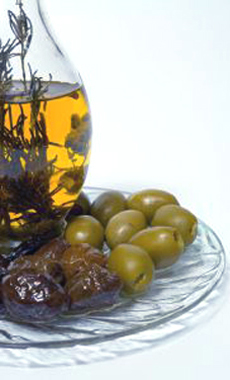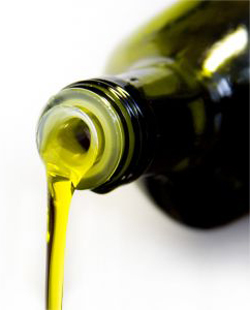
 Each cultivar (variety) of olive has its own flavor and aroma characteristics, which can vary by region due to “terroir.” Photo of Greek olives and olive oil by Yiannis Papadimitriou | SXC. Each cultivar (variety) of olive has its own flavor and aroma characteristics, which can vary by region due to “terroir.” Photo of Greek olives and olive oil by Yiannis Papadimitriou | SXC.
ABOUT THE AUTHOR |
| KAREN HOCHMAN is Editorial Director of THE NIBBLE. She has a fondness for green and grassy olive oils. |
|
November 2005
Last Updated March 2012
|
 |
The Flavors & Aromas of Olive Oil
How To Taste & Evaluate Olive Oil ~ Part II
Olive Oil Flavors
PART II
Styles Of Olive Oil
Olive oil can show a broad variety of desirable flavors depending on the type of olive, region and terroir, maturity, processing, age, and other factors (there are also undesirable flavors, stemming from flawed production and old oil). While the more than 200 different varieties of olive can be expected to produce a broad range of flavors and styles. Different people will have different classifications, but one way to look at oils is by style or flavor profile:
- Intense: Full-Bodied & Earthy. Strongly-flavored, big oils for those who like full flavor and rich mouthfeel. Can have a peppery punch as well. Best used with strong-flavored foods.
- Robust: Fruity & Peppery. More olive flavor, more verdant flavor, very often accompanied by a peppery aftertaste, Best used with pasta dishes, robust soups, or as a finishing drizzle.
- Moderate: Smooth & Buttery. Luscious, fruitier oils that retain a sense of delicacy; best used on salads, vegetables, poultry.
- Moderate: Fruity & Herbal. These are the herbal, grassy oils. One of our favorites, delicious on anything but especially with vegetable, pasta and seafood dishes.
- Mild: Subtle & Nuanced. Delicate, ethereal olive oils with complexity; best used for the lightest dishes, such as grilled white-fleshed fish or fresh mozzarella.
Olive oil is unusual in flavor profile, because two qualities that can be questionable in other foods—bitterness and pungency (which appears as a peppery bite in the back of the throat)—are positive qualities here. The third quality to look for is fruitiness, the actual olive flavor. (It’s a good time to make the point that, despite that it is savory and not sweet, the olive is, in fact, the fruit of the olive tree, and not a vegetable.)
There are many other nuances of flavor and aroma to be found in olive oils. Different cultivars (the comparable word for grapes is variety) yield different qualities, as do different terroirs and microclimates.
The terms below are divided into desirable and undesirable qualities. Some terms can be both, depending on the extremes in which they appear. The Olive Oil Sensory Wheel can help you quickly make sense of, and speed up your master of, the many aromas and tastes of virgin olive oil.
There are so many wonderful olive oils on the market. Just as you have your favorite Cabernet Sauvignons and your favorite Chardonnays, you’ll enjoy discovering your favorite extra virgin olive oils.
- Just as wines pair to specific foods, so do olive oils: those that are good for meats may be too strong for some delicate fish.
- An oil that is exquisitely delicious on its own can be drizzled straight on pasta or salad; a more bland oil can be blended with flavorful vinegars and citrus for a tasty dressing.
- Strong oils make good bread dippers.
|
|

Photo by Pawel Krilj | SXC. |
See if there’s a store in your town that specializes in olive oil. They will have someone who can guide your choices, and may also have informal tastings as well as formal classes where you can learn more. Take a look at some of our favorite books about olive oil.
Continue To Page 2: Olive Oil Flavor Chart
Go To The Article Index Above
Lifestyle Direct, Inc. All rights reserved. Images are the copyright of their individual owners.

|




 Each cultivar (variety) of olive has its own flavor and aroma characteristics, which can vary by region due to “
Each cultivar (variety) of olive has its own flavor and aroma characteristics, which can vary by region due to “